Afterschool programs teach students tech as LAUSD restructures
When Jonathan Marcelino’s parents told him he could either own a computer or a cell phone, the decision was not difficult for the 17-year-old to make.
As the eldest of four children born to Mexican immigrants living on a tight budget in Nickerson Gardens, a Watts public housing project, Marcelino knew that although he would have liked to have a phone to regularly text friends, a computer would be more productive.
“Regardless of where I go, I want to study computer science,” he said. “I want to do cool stuff, make money and then do a nonprofit. That’s why you don’t see me running with a phone.”
The lack of exposure to technology and its practical applications in daily life is a reality many students living in and around South Los Angeles face, Marcelino said.
Recuperative Care Center aims to aid homeless in South L.A.

The MLK Recuperative Care Center, open to patients starting Jan. 5, is housed in a former dormitory for Charles Drew University medical students. | Marc Trotz, LA County Department of Health Services
Next month the Los Angeles County Department of Health Services plans to open a recuperative care facility adjacent to the Martin Luther King Community Hospital. The facility will treat homeless patients who have been discharged from the hospital or the nearby county-owned Martin Luther King Jr. Outpatient Center.
“If you’re homeless and you’ve been discharged from the hospital you often don’t have anyone to treat your wounds, change the dressings or help you manage with a broken leg,” said Marc Trotz, director of DHS’ Housing for Health program. “You can’t deal with these conditions properly if you are living on the streets.”
The MLK Recuperative Care Center, which will begin accepting patients Jan. 5, will be housed on the hospital campus, in a former dormitory for Charles Drew University medical students. The center will have 50 rooms and 100 patient beds, making it the county’s largest facility of its kind.
[Read more…]
Grant money will lay roots for tree planting in South L.A.
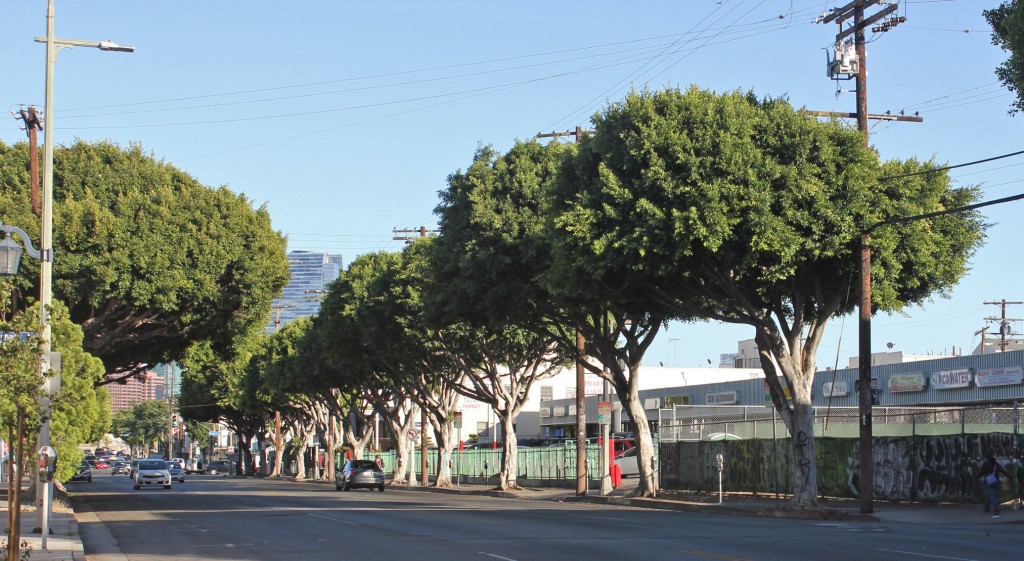
The goal of the grant KYCC received is to ensure half of the possible tree sites in South Los Angeles and Pico-Union are planted, creating consistent shade coverage. | Rachel Cohrs, Intersections South L.A.
One community organization has a grant to plant trees in South Los Angeles, but first it has to convince local residents that picturesque, tree-lined streets aren’t just for neighborhoods in Beverly Hills.
“If you’re struggling on a daily basis, trees might not be the first things you’re thinking about. These communities deal with crime, a large homeless population, illegally dumped trash, graffiti, and gang violence … Most people are just trying to get by,” said Ryan Allen, Environmental Services Manager of Koreatown Youth and Community Center (KYCC).
However, Allen and the staff at KYCC know that planting trees can have positive effects in low-income communities. The benefits of having densely planted trees include reduction of energy costs, creation of shade, and the beautification of neighborhoods.
In neighborhoods like South Los Angeles and Pico-Union, which both scored poorly in air quality evaluations, planting trees can help reduce the effects of pollution by removing toxins from the air.
“One tree on its own will do those things, but there is the idea of strength in numbers,” Allen said.
KYCC received nearly $330,000 in grant money from the California Department of Forestry and Fire Protection to make the vision of dense tree cover a reality in the South Los Angeles and Pico-Union areas.
The funds stem from a cap-and-trade program passed in California in 2006 to reduce greenhouse gas emissions. Under cap-and-trade, companies have to pay for emissions over a certain limit, increasing the incentive to reduce air pollution. At least 25 percent of the revenue from the program is distributed to greenhouse gas emissions-reducing projects in low-income neighborhoods.
South Los Angeles struggles with high levels of pollution that are compounded by other problems. A case study of the area shows that the South Los Angeles area is “disproportionately burdened” by poverty, unemployment and linguistic isolation.
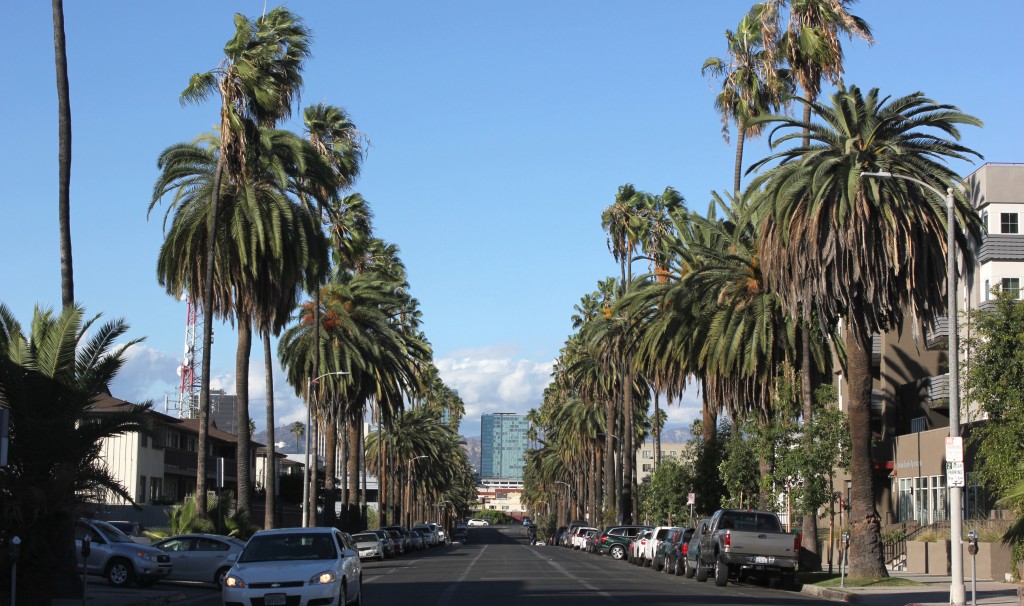
KYCC helped plant small trees between other trees to create shade cover on this street in South Los Angeles. | Rachel Cohrs, Intersections South L.A.
KYCC got the grant to plant 1,120 trees over a four-year period starting in 2016. Its goal in the project is to use the grant to see that at least half of the potential tree sites on neighborhood streets planted.
After the initial planting, KYCC will provide funding to maintain the trees for the first three years. After that, the trees will have grown substantially and will need less maintenance work. Despite the benefits of having trees planted, not everyone is on board with the plan.
Community members have voiced concerns about tree roots breaking up sidewalks, having to water, prune and maintain the trees, and the trees dropping leaves. Allen also cited a mental barrier that trees might not fit the culture of South Los Angeles neighborhoods. In the past, trees planted incorrectly caused sidewalks to crack and fall into disrepair.
That’s what the KYCC grant is for. Beyond buying trees to plant, the organization plans to reduce barriers and address community concerns. If community members voice worries, then KYCC can use some of the grant money to remove stumps or invasive trees, repair sidewalks, check sewer lines, and other incentives.
“We are going to try to address different concerns people could have so they don’t have reason to say no,” Allen said.
KYCC is qualified to mitigate these potential issues because the organization has been involved in tree planting efforts since 1999, and has expertise in selecting the right tree species and planting them in the right places to ensure they won’t damage sidewalks.
The task of physically getting the trees planted is expected to be an undertaking that will require community engagement. Previously, KYCC has gone door to door knocking and asking if residents would like a tree. The new grant is based on individuals taking responsibilities for their own streets and talking with their neighbors to get trees planted.
KYCC also plans to help organize community planting events to help get residents’ hands dirty and encourage involvement with the cause.
“It takes somebody dedicated, and a certain amount of legwork to work with neighborhood and to get people interested,” Allen said.
KYCC will be working through community organizations to streamline the process. Allen said the team is just now beginning to work with other organizations from existing partnerships and make new connections.
One new organization KYCC could be partnering with for a tree planting project on a different grant is the Redeemer Community Partnership.
Redeemer has an independent initiative focused on Jefferson Boulevard to “Make Jefferson Beautiful” by beginning a tree canopy, repairing sidewalks, and integrating bike lanes for safer transportation. Niki Wong, the lead community organizer at Redeemer Community Partnership, said she wants all the area surrounding USC to benefit from the university investment.
Tree cover on Jefferson on the USC side versus the community side
“USC is right next door. Vermont Avenue kind of serves as this invisible line between two cities….Part of what we are hoping to do is kind of dissolve that line and make the closeness beneficial for folks in the neighborhood,” Wong said.
Wong said one of the most important benefits of partnering with KYCC on a tree planting project is the commitment to long-term maintenance and community engagement. The grant Wong applied for through the Los Angeles Neighborhood Initiative would maintain 15 trees, plant 14 new trees, and replace two dead trees. Although the shade will not be provided immediately, within a few years well-tended trees will provide the full benefits.
Besides the environmental advantages of having trees planted, Wong also said attractive tree cover could encourage residents to go outside more and help draw businesses to the area.
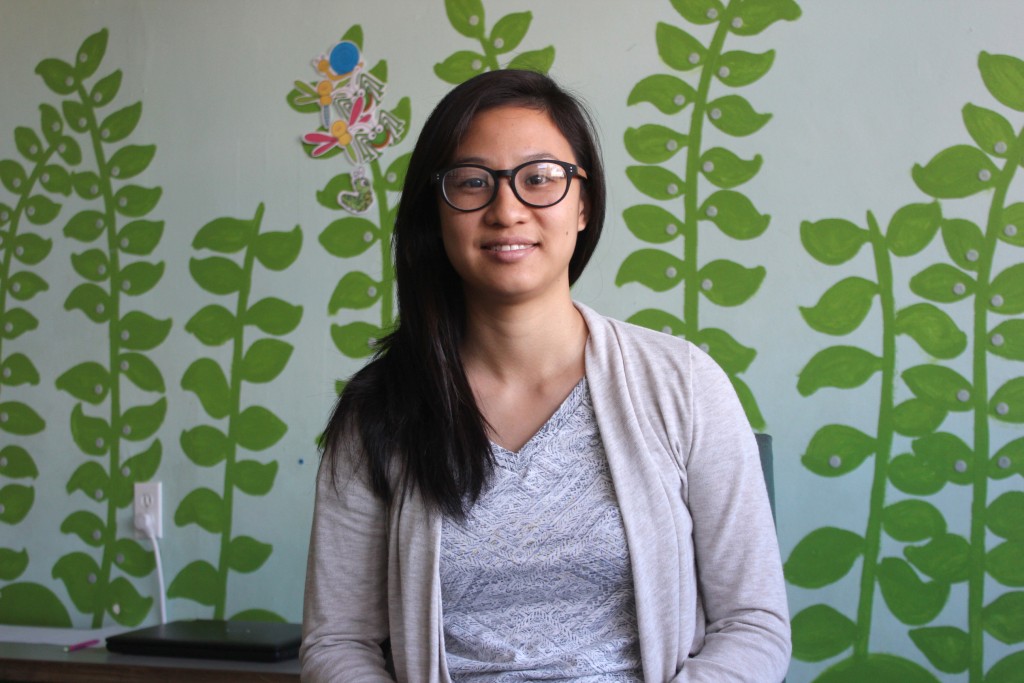
Niki Wong works with Redeemer Community Partnership to get grants to make Jefferson Boulevard safer and more beautiful. | Rachel Cohrs, Intersections South L.A.
Further, Wong pointed out that even though grant money is being set aside to help remedy these problems, under-resourced communities may not have the time or expertise to complete complicated grant application processes.
“This is for a community that has been overlooked, and at the bottom of the priority list for all sorts of improvements. Our crosswalks are faded, our sidewalks are broken, and a lot of tree wells are empty or have dead trees in them. It’s just very clear that there has been neglect,” Wong said.
Applications for annual grants will be available for the KYCC grant funds in the spring. Community organizations can apply and individuals can also get support to build up a tree canopy in South Los Angeles. Both Wong and Allen emphasized that in order to move forward with the projects, community support and engagement is essential.
“We want to be helping communities and residents to make their vision for a better neighborhood happen,” Allen said.
What happens when an aspiring teen chef from South L.A. meets the U.S. Surgeon General? + Did you buy a Powerball ticket in South LA? Claim your $866K prize!

Fremont High School senior Xiaxiang English served a chard-based salad to to the U.S. Surgeon General Friday. | Marisa Zocco, Intersections South L.A.
What happens when an aspiring teen chef from South L.A. meets the U.S. Surgeon General?
Fremont High School senior Xiaxiang English stood alongside U.S. Surgeon General Dr. Vivek Murthy on Friday, promoting nutrition and access to fresh fruits and vegetables as a preventive health measure. (Los Angeles Times)
Did you buy a Powerball Ticket in South LA? Claim your $866k prize!
The California Lottery announced Thursday that a winning lottery ticket purchased at a Florence neighborhood meat market in South L.A. remains unclaimed. (MyNewsLA.com)
Renata Simril to succeed Anita DeFrantz as head of LA84 Foundation
Former Dodger and LA Times executive Renata Simril was announced the CEO of LA84 Foundation on Wednesday. The foundation is endowed with 40 percent of the surplus of the 1984 Olympic Games and has funded more than $225 million in grants to support youth sports programs in Southern California. (MyNewsLA.com)
Help L.A. students name the Crenshaw/LAX tunnel boring machine
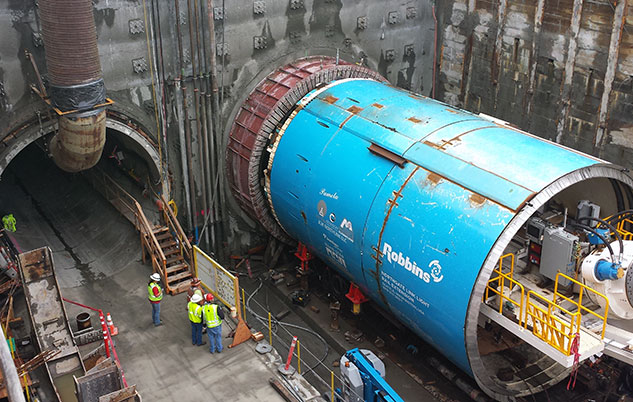
The Crenshaw/LAX line’s twin tunnels will be carved out by a soon-to-be-named tunnel boring machine (TBM) similar to Pamela (pictured in blue), which was used to carve out the Northgate Link Extension in Seattle, WA. | Sound Transit, Flickr Creative Commons.
In keeping with a 700-year-old mining tradition, Metro plans to give a female name to the tunnel boring machine (TBM) that will excavate the twin tunnels for the Crenshaw/LAX line.
But it needs the public’s help.
Metro is requesting public participation in voting to select the LAUSD student-submitted name and artwork to be featured on the machine during an early 2016 lowering ceremony.
Although the TBM has “boring” spelled out in its moniker, the process of keeping with mining history has been anything but. Rather, it’s been a creative process.
LAUSD students in sixth to 12th grades submitted their choice of either a 200-word essay or two-minute video outlining why a suggested name would best suit the 950-pound, 400-foot-long machine.
Additionally, students in kindergarten through fifth grade entered artwork to be featured alongside the winning name.
Representatives from Metro, the office of L.A. County Supervisor and Metro Board Chair Mark Ridley-Thomas, Walsh/Shea Corridor Constructors and staff, and the Crenshaw Community Leadership Council selected the finalists from a pool over more than 200 entries submitted since June.
The top 10 name finalists are Lorena (Lorena Weaver), Sojourner (Sojourner Truth), Maya (Maya Angelou), Eleanor (Eleanor Roosevelt), Harriet (Harriet Tubman), M.A.C. (Make A Change), Sally (Sally Ride), The Africana, Rosa (Rosa Parks), and Athena.
Three student contest winners from each category will be awarded with a $100, $200 or $300 TAP card during the lowering ceremony. Voting for the favorite name and artwork is open now through Dec. 1.
Digging 60 feet per day, it will take a year for the TBM to excavate the 1-mile twin tunnels beginning at the northeast corner of Crenshaw Boulevard and Rodeo Road and will connect the Crenshaw/Expo, Martin Luther King Jr. and Leimert Park underground stations.
The tunnel boring is a part of the construction of the more than $2 billion Crenshaw/LAX light-rail project that will connect the Green and Expo lines. The new route will consist of eight new stations to serve the Crenshaw, Inglewood and LAX communities. It is expected to open in 2019.
South LA youth, non-profits sue city over neighborhood oil drilling
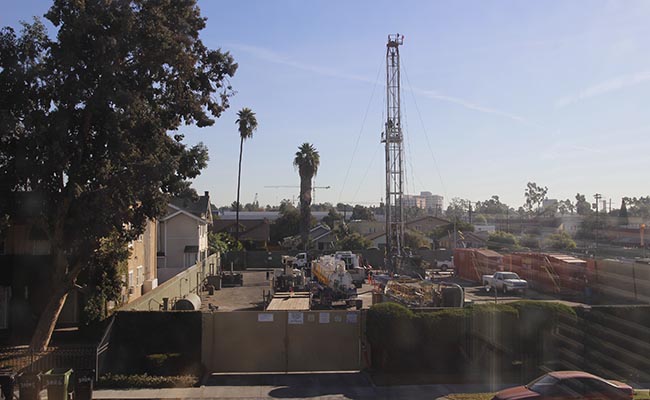
At its closest point, the Jefferson drill site is only three feet from homes. | Caitlyn Hynes, Intersections South L.A.
A few blocks west of the University of Southern California, behind ivy-covered walls, is the Jefferson oil-drilling site. The walls may block neighbors from seeing what goes on behind them, but they know, nonetheless.
Now, South Los Angeles youth, tired of living near toxic chemicals with little protection, are joining together with environmental non-profits to sue the city.
The Jefferson drilling site, owned and operated by Freeport-McMoran Inc., is one of the sites named in a lawsuit brought against the city. Located in the heart of a South Los Angeles neighborhood, the site is protected only by a retaining wall that neighbors say does little to contain the noise and odors produced by drilling. Other South L.A. sites face similar problems.
The plaintiffs in the lawsuit, the South Central Youth Leadership Coalition, Communities for a Better Environment, and the Center for Biological Diversity, held a press conference last Friday to announce the case. The groups allege that the city has not only violated regulations from the California Environmental Quality Act by issuing exemptions for environmental impact reports on oil drilling and production sites, but that it has also forced residents of color to bear disproportionate environmental and health burdens because of the lack of safety measures around several South Los Angeles sites.
Standing outside City Hall Friday with signs with that read, “Our health is not for sale” and, “Ain’t no power like the power of youth,” the minors stood behind speakers who demanded that the city comply with the California Environmental Quality Act by conducting environmental impact reports and providing better protection from, odors, toxins and noise pollution at the drilling sites.
“Our health and our environment are at risk. Community members should not have to jeopardize their health by simply being at home,” high school student Joshua Navarro told the press.
The lawsuit comes on the heels of an October audit that found that since 2007, most Los Angeles oil sites have not been subjected to an environmental impact report assessing the site’s health and environmental impacts on surrounding communities.
Reports from Al-Jazeera America found that the Jefferson drilling location is one of the sites lacking such documentation. It is currently unclear why these oversights have continued.
Protests and this lawsuit against oil companies have drawn the support of youth who live in the neighborhoods surrounding the Jefferson drill site. Many of the kids involved have lived around the site for years. They’ve smelled the chemicals and heard the loud sounds that often accompany drilling.
Elena Hume, 10, has been involved with several protests. She said she and her family would smell the chemicals as they went on walks around their neighborhood.
“I never knew it was an oil-drilling site. We’d see the bushes, and the rows of trees, and the big yellow gate,” Hume said. But now she knows what is happening and she feels it’s wrong to expose her neighborhood to the fumes of the toxic chemicals.
Jordan Parks, 12, has lived near the site his entire life. For a long time he and his family didn’t know exactly what was behind the walls. But when his father discovered it was an oil-drilling site, “Everyone started realizing how incredibly bad it was,” Jordan said.
Youth from the neighborhood around the Jefferson site, brought together by school, church and neighborhood tutoring programs, have become more involved in the issue through protests at the drilling site over the past few years.
Richard Parks, Jordan’s father, said that the kids were the ones who wanted to take action. He said the youth wanted to initiate the process because their homes and families were being directly affected.
A report from the National Resources Defense Council found that the chemicals used at oil drilling sites have been linked to cancer and other reproductive health problems. Neighbors have also blamed the site for headaches, nosebleeds and asthma.
Tanja Srebotnjak, a professor at Harvey Mudd College who has worked in oil and gas research for over fifteen years, said that the closer neighbors are to the chemicals used at oil drilling sites, the more susceptible they are to health complications.
“Farther is better and some states and municipalities have set distances ranging…up to 1,500 feet, 2,000 feet,” Srebotnjak said.
But a 2014 Community Health Councils study found that South L.A. drilling sites located in neighborhoods with high percentages of people of color were significantly closer to homes, schools and churches than sites in West L.A.
While the average distance from homes, schools and churches in South L.A. is 85 feet, the West L.A. and Wilshire sites, located in primarily white neighborhoods, are about 400 feet away.
Many West L.A. sites also have enclosed structures or some type of geographic barrier like a golf course that can help mitigate noise and odors. The Jefferson site, in contrast, has only a retaining wall as physical protection.
Niki Wong of Redeemer Community Partnership, a South L.A. non-profit that works in the neighborhood around the Jefferson drill site, estimated that the wells at the site are a mere 60 feet from homes, a distance that almost certainly exposes residents to toxins. Without an environmental impact report, it is hard to know exactly how the community would be affected if an explosion or other accident were to happen on the site.
Wong said that it is key to involve the youth of the neighborhood in this effort. “It’s important for them [to recognize] the need for a healthy and safe environment to grow up in.”
As for the kids around the Jefferson drill site, they say they just want their neighborhood to be safe for families. “It’d be nice if they just shut [the drilling site] down and turned it into a park or something, or more housing,” said Jordan.
The city attorney’s office told the Los Angeles Times that it will review the lawsuit.
SCLARC Opens New Headquarters + L.A. Extends Shelter Program for Homeless

South Central Los Angeles Regional Center Opens New Headquarters: South Central Los Angeles Regional Center (SCLARC), celebrated the grand opening of Legacy Plaza— the agency’s new headquarters — with a ribbon-cutting ceremony on Nov. 14. (Compton Herald)
L.A. to Extend Shelter Program for Homeless: With winter setting in and an El Nino weather pattern eyeing California, officials extended a campaign to help nearly 26,000 homeless people by opening public buildings as temporary shelters. (Fox News)
An Architectural Walking Tour of South L.A.’s Stately and Historic West Adams Boulevard:
South L.A.’s West Adams neighborhood is home to an array of architectural styles and several Historic-Cultural Monuments that have stood the test of time. Curbed LA mapped 13 of the neighborhood’s must-see spots that can be knocked out in a 2-mile stroll. (Curbed LA)
South LA youth sue the city + High winds sweep across LA

Los Angeles neighborhoods experienced high winds last weekend. (Caitlyn Hynes / Intersections South LA)
The sad, sickening truth about South L.A.’s oil wells: South LA youth are suing the city for unfairly exposing them to toxins found at oil drilling sites in the city. (Grist)
Los Angeles walloped by winds as cold front moves south: Los Angeles residents saw high wind speeds last weekend after a coldfront moved across the region. (KPCC)
Coding boot camps emerging as supplement to traditional tech instruction

Gregorio Rojas stands with his most recent cohort of students who participated in his coding boot camp. | Photo courtesy of Gregorio Rojas
Coding boot camps, long on the fringe of traditional education spheres, are pushing their way into national conversation of how to attract more Americans into the STEM fields.
These boot camps, a product of the technology boom, are technical training programs designed to expose novice students to the most important aspects of the coding and web development field while guiding them to become innovators. Oftentimes boot camps lead students into jobs in the science, technology, engineering and mathematics industries.
Last month, the Department of Education rolled out its pilot program, EQUIP. The program, which is now open for application, allows colleges and universities to partner with non-traditional education models like boot camps, and gives students access to federal financial aid.
EQUIP is part of a growing initiative to help underwrite the cost of attending satellite programs that train students in career fields the country needs–particularly in the STEM fields in which the Obama Administration has encouraged more growth.
Yet, the concept of the recent policies supporting coding boot camps is not new in South Los Angeles. EQUIP would be supporting an educational model that has already taken root in the area, some educators say.
A few years ago, Gregorio Rojas and his wife founded Sabio, a startup focused on providing software development training to women and minorities. At Sabio, students spend 6 to 12 weekends in intensive programs learning to code, develop software and hone technical skills. At the end they hold the promise of standing on their own in the competitive STEM industries.
“One reason I do this is because I pretty much learned this way,” Rojas said of the boot camps. “It’s hands on, on the job, intense and very focused. I got into the industry right before the dot-com bubble burst. These skills facilitated my own entry.”
His coding boot camp is based in Culver City, but Rojas said many of his students have ties to the South L.A. community.
At boot camps, students spend hours learning code language — not from a book, but by implementation. The experience is intense, but the success of the methodology is proved each time Rojas’ students walk away with a firm grasp of the material and are later gainfully employed. Many times, students participate in hackathons, holding their own against competition.
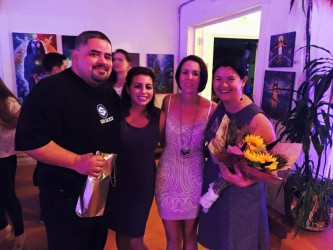
Gregorio Rojas (left) celebrated the launch of two of his students’ apps to the Apple Store. | Photo courtesy of Gregorio Rojas
Recently Rojas celebrated the launch of two students’ app now featured in the Apple Store. Both creators of the app had been in two wildly different fields before the coding boot camp; one was a Spanish professor and the other was working in the financing world. At Sabio, the average student is a 30-year-old, according to its founders.
In the basement of South LA’s Southside Church of Christ, Chris Baccus also runs a coding boot camp — this one aimed at middle schoolers. Baccus, executive director of Concerned Citizens Community Involvement, helps run the camp on Saturdays. In one year, seventy students have gone through the non-profit’s Limitless STEM Academy.
The wide range of participant ages for the coding boot camps in South Los Angeles show the demand for alternative education models. Generally the camps are also less expensive options when compared to the norm.
At Sabio, a three-month program costs $13,450 though it is set to increase 7 percent to $14,450 in 2016.
Comparably, the estimated yearly cost for attending the University of Southern California, a four-year semi-private institution is $67,212, while the all-expense-covered yearly tuition for a University of California school is $33,600 for in-state residents. At a California State University such as Cal State LA, to receive a computer science degree, students would pay around $32,240. Most students would quadruple these costs during the four-year pursuit of a bachelor’s degree.
For an associate’s degree in computer information systems at Los Angeles Trade-Tech College, California residents pay around $2,070.
Baccus’ Limitless STEM Academy held on Manchester Avenue and Harvard Boulevard is free of charge for the middle school students.
Rojas sees EQUIP as a federal commitment to embracing more innovative styles of teaching and a sign that this type of instruction is working.
“People are going to start waking up and realize that what they do is not traditional but it’s theory,” Rojas said. “Those institutions want to tap into these resources and bring them into the fold. These are conversations that have been happening for at least a year now.”
Boot camp organizers said they not only see such programs as great supplements to educational systems for their students, but in some cases their curricula can help drive STEM instruction in the traditional classrooms.
Read More: Teens Exploring Technology celebrates grand opening of community space
Baccus pointed to the Los Angeles Unified School District, which has been struggling to integrate emerging technology into its curriculum.
“I’ve worked at LAUSD for 17 years so I understand the challenge that some of our schools have in implementing innovative programs because everything is all-around taught to a test,” Baccus said.
Not discouraged, Baccus said he’s looking to spread his program into Inglewood and Compton to reach more students.
“In the future we want our students to be able to be problem solvers because that skill never grows old,” he said. “As technology advances, it just becomes an easier way to solve a problem and if you can, then you’ll always have a job. You don’t wait, you create your own opportunity.”
Baccus has talked to academics at traditional colleges who have requested his help trying to integrate structures like that of Limitless STEM Academy into their classroom. One philosophy the boot camps have integrated is the dedication to serving underrepresented communities, such as women, African American and Latino populations. They’re helping to facilitate the next generation of minority students entering the tech field.
“[At Sabio] you have a Latino immigrant and Latina CEO coming out here and running things,” Rojas, who is a Colombian immigrant, said. “I don’t think you’re going to find something else like this.”
Rojas’ wife and Sabio co-founder, Liliana Monge, is Mexican and grew up in South Gate. Baccus also said he believed his students seeing other people of color working in tech encourage them to continue breaking into the ever-changing industry.
“The more qualifiers you have, the easier it is for minorities to sit at the table with people who may be unfortunately less qualified, but may have a network that allows them to get opportunities that we traditionally have been left out of, especially in STEM and technology and computers,” Baccus said. “Any more ammunition they get to put in their toolbox is absolutely great.”
Diversity, however, is not just essential in South Los Angeles. Diversifying the industry overall breeds better innovations in the field.
“Coding software development is supposed to be one of the leading innovative industries in the world – in the planet really, but by design for a bunch of different factors is the least innovative group out there,” Rojas said. “We don’t have enough women and people of color in the room to challenge the other folk in the room.”
Baccus hopes that the progress in terms diversity and technology will continue to take root, and eventually become a requirement for younger students.
“I would love to see [EQUIP] interfused with the curriculum for students even before high school to give them the skills they would need,” Baccus said. “Help them do that self-discovery before they get into those pathway programs.”














